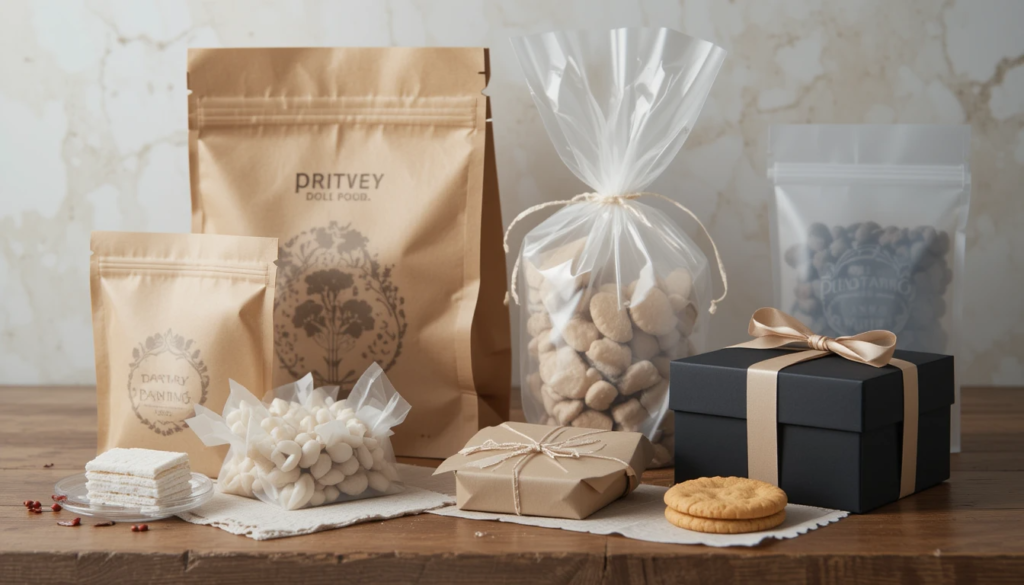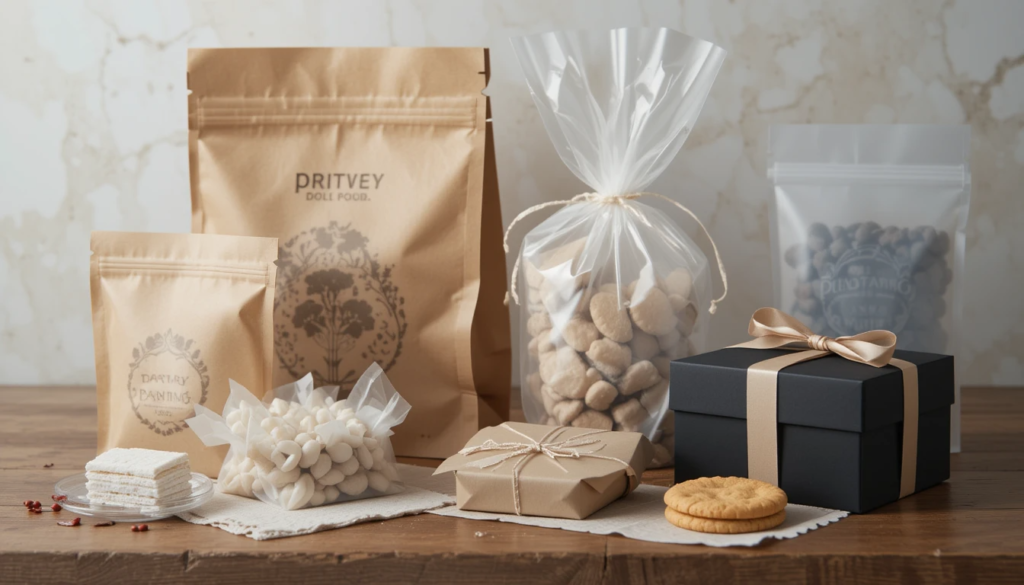Table of Contents
Selling homemade chocolate chip cookies is a great way to turn your baking skills into a business. Whether you’re starting a small bakery, looking to sell cookies at local farmers’ markets, or simply hoping to offer a treat at school events or online, proper packaging is a crucial element that can make or break your sales. Learning how to package chocolate chip cookies to sell is essential for turning your homemade treats into a professional product that not only looks great but also stays fresh for your customers.
As you start learning how to package chocolate chip cookies to sell, it’s essential to know a bit more about the history and popularity of this beloved treat. If you’re curious, check out 10 Interesting Facts About Chocolate Chip Cookies to discover some fun insights that might inspire your packaging approach.”
Packaging not only preserves the freshness and flavor of your cookies but also plays a key role in your branding strategy. In this article, we’ll cover everything you need to know about how to package chocolate chip cookies to sell, from choosing the right materials to making your product stand out. By the end, you’ll be equipped with the knowledge and confidence to package your cookies like a pro.
Best Chocolate Chip Cookie Packaging Ideas for Selling
Packaging is one of the first things customers notice when they buy a product, and it can significantly impact their buying decision. When it comes to cookies, attractive and effective packaging serves multiple purposes:
- Preservation: Proper packaging keeps your cookies fresh by protecting them from moisture, air, and contamination.
- Branding: Packaging is a powerful branding tool that can showcase your business’s personality and values.
- Convenience: Good packaging makes it easy for customers to store and transport the cookies.
- Appeal: Well-packaged cookies look professional and irresistible, which can increase sales.
In fact, customers are more likely to pay a premium for products that are beautifully packaged, as it gives the impression of high-quality and care. So, let’s dive into the steps you should take to package your chocolate chip cookies successfully.
Creative Cookie Packaging Tips to Boost Sales
Thinking outside the box can help you stand out from the competition. There are numerous creative ways to package chocolate chip cookies to sell that can draw customers in and make them more likely to purchase. Whether it’s through unique cookie boxes, personalized tags, or fun packaging shapes, creativity will help your cookies shine.
1. Choosing the Right Materials for Chocolate Chip Cookie Packaging

The first step in packaging your cookies is selecting the best materials that will protect the product while also looking visually appealing. Consider these packaging options:
- Plastic Bags: Clear, resealable plastic bags are a cost-effective and convenient option. They are perfect for individual or small batches of cookies and allow customers to see the product inside. Choose food-grade plastic that’s durable and BPA-free.
- Cellophane Bags: For a more upscale look, cellophane bags can give your cookies a shiny, professional appearance. These are also eco-friendly and biodegradable, which is appealing to environmentally-conscious customers.
- Boxes: Cookie boxes provide a more premium option and are great for larger orders or gift packaging. You can use kraft paper, corrugated cardboard, or decorative printed boxes to suit the look of your brand.
- Tin Cans or Jars: For a more rustic and high-end presentation, you could package your cookies in tin cans or glass jars. These options are perfect for gift packaging and can be reused, making them an eco-friendly choice.
- Paper Wraps or Pouches: If you want something more minimalistic or vintage, consider wrapping your cookies in parchment paper, wax paper, or kraft paper pouches. These materials are sustainable and give your product a homemade touch.
2. How to Package Cookies for Freshness and Appeal
In addition to protecting your cookies, it’s vital to ensure they remain fresh. If you don’t know how to package chocolate chip cookies to sell in a way that locks in freshness, your cookies may lose their appeal. Here’s how you can protect your cookies during storage and transport:
- Individually Wrap Each Cookie: Wrapping each cookie individually helps keep them fresh and prevents them from sticking together. You can use wax paper or parchment paper to wrap each cookie before placing them in bags or boxes.
- Use Padding: For fragile or delicate cookies, add some padding inside the packaging. Tissue paper, bubble wrap, or crinkle paper can help protect cookies from breaking and give your packaging a more luxurious feel.
- Resealable Zipper Bags: Zippered bags are a great way to preserve freshness and extend shelf life. They seal in the aroma and moisture, ensuring your cookies remain soft and chewy.
- Add Freshness Sealers: If you’re using boxes, consider adding a freshness sealer or a small packet of silica gel to keep moisture at bay. You can also opt for vacuum sealing for the best freshness protection.
3. Design and Branding Your Packaging
The design of your packaging should align with your brand image. Whether your cookies are gourmet or homemade, your packaging needs to reflect the personality of your brand. Here are some tips to help with the design:
- Create a Custom Logo: A logo helps identify your business and gives your cookies a professional look. Ensure your logo is clear, simple, and memorable.
- Use Bright, Appealing Colors: The colors you use in your packaging should catch the eye of potential customers. For chocolate chip cookies, warm colors like brown, gold, or red can evoke feelings of comfort and indulgence.
- Include Ingredient Information and Labels: Be transparent with your customers by including ingredient lists, expiration dates, and any certifications (such as organic, gluten-free, or nut-free). Labels add authenticity and provide essential information to buyers.
- Add a Personal Touch: Many customers love a personal touch. You could add a small handwritten note or a thank-you message with each purchase. This helps create a connection with your audience and encourages repeat business.
- Include Social Media and Contact Info: To build brand loyalty and keep your customers coming back, make sure your social media handles, website, and contact details are easy to find on your packaging.
4. Consider the Size and Portion Control
When selling cookies, offering small batch options can be a great way to cater to customers who want a quick, personalized treat. If you’re looking for inspiration, check out our guide on Small Batch Chocolate Chip Cookies: The Perfect Treat. It’s important to offer a variety of portion sizes. Some customers may want a single cookie for a quick snack, while others may prefer to buy a larger box for family gatherings or parties. Offering multiple sizes not only increases your chances of selling but also gives customers more options to suit their needs. Here are a few ideas:
- Single Cookie Packaging: For on-the-go customers, individually wrapped cookies can be sold as single units. These are perfect for impulse buys or vending machines.
- Multi-Cookie Bags: You can also sell your cookies in bags containing 4 to 12 cookies. This option appeals to customers who want more value for their money.
- Cookie Boxes or Tins: For gifts or special occasions, large boxes or tins filled with a variety of cookies can make an appealing gift option. You can customize the packaging for holidays or events, adding extra appeal.
5. Add a Finishing Touch with Creative Tags and Ribbons

To make your cookies even more special, add finishing touches like creative tags, ribbons, or other decorative elements. These can enhance the look of your packaging and make it more memorable:
- Bows and Ribbons: Use satin, twine, or grosgrain ribbons to add a touch of elegance to your cookie packages. You can tie them around the bags or boxes to make the packaging pop.
- Personalized Tags: Attach personalized tags with messages like “Thank you for your purchase” or “Handmade with love.” This adds a thoughtful and unique element to your packaging.
- Seasonal Touches: For holidays or special occasions, consider adding seasonal decorations like holiday-themed ribbons, stickers, or custom-printed cards.
6. Comply with Legal Requirements and Food Safety Standards
When selling food products, it’s important to comply with local laws and food safety regulations. Here’s what to keep in mind:
- Labeling Requirements: Depending on your location, you may need to include certain information on your packaging, such as allergen warnings, ingredients, and nutrition facts.
- Food Safety Compliance: Make sure your cookies are made in a clean, safe environment and adhere to food safety standards. If necessary, get certified to give customers peace of mind.
- Expiration Dates: Always include a “best by” or expiration date on your packaging to ensure your customers know how long your cookies will stay fresh.
FAQs: Eco-Friendly Packaging Options for Chocolate Chip Cookies
When you figure out how to package chocolate chip cookies to sell, don’t forget to add a personal touch that resonates with your brand. This can include adding a custom label or a thank-you note, which not only makes the customer feel special but also strengthens your brand identity.
What Are the Best Materials for Packaging Chocolate Chip Cookies?
When it comes to selecting packaging materials for your chocolate chip cookies, it’s essential to balance durability, aesthetics, and functionality. Some of the best options include:
- Plastic Bags: A great choice for single or small batches of cookies. Choose food-safe plastic bags that are clear to showcase your cookies, or go with resealable versions to maintain freshness.
- Cellophane Bags: These provide a more upscale look and are biodegradable. They can give your cookies an elegant, shiny appearance while keeping them fresh.
- Cookie Boxes: If you’re selling cookies in larger quantities or want to offer gift packaging, opt for sturdy cardboard or kraft paper boxes. These materials can be printed with your logo and branding and make for an attractive, premium option.
- Tin Cans and Jars: If you want to create a rustic or luxurious feel, you can use tin cans or jars. These are perfect for gifting and create a lasting impression.
Each packaging option comes with its pros and cons, so choose what aligns best with your brand image and customer expectations.
How Can I Make My Packaging Eco-Friendly?

In today’s world, customers are becoming more environmentally conscious, and opting for eco-friendly packaging can improve your brand’s appeal. Here are some ways to make your cookie packaging eco-friendly:
- Use Biodegradable Materials: Cellophane bags, paper boxes, and tissue wraps are biodegradable and can be disposed of without harming the environment.
- Minimal Plastic Usage: While some plastic packaging options are essential for freshness, limit the use of single-use plastics and consider compostable or recyclable plastic bags.
- Repurposable Containers: Using glass jars, tin cans, or reusable pouches encourages customers to reuse your packaging, making it more sustainable in the long run.
- Eco-Friendly Inks and Labels: When printing your logo and brand information, opt for eco-friendly inks and sustainable paper for your labels and tags.
How Do I Ensure My Cookies Stay Fresh During Transit?
Maintaining the freshness of your chocolate chip cookies during transport is crucial to ensuring they reach your customers in top-notch condition. Here are some tips to help:
- Individually Wrapped Cookies: Wrapping each cookie helps prevent them from sticking together and preserves their freshness. Wax paper or parchment paper are great choices for wrapping cookies.
- Use Resealable Packaging: For larger quantities, use resealable bags or boxes with airtight seals to keep moisture out.
- Add Freshness Packs: Include moisture-absorbing packets or desiccants in your packaging to keep your cookies fresh longer.
- Consider Vacuum Sealing: If you’re shipping cookies or storing them for extended periods, vacuum sealing is an excellent option to maintain their freshness by removing air from the packaging.
Do I Need to Include Nutrition Information on My Packaging?
The requirement to include nutritional information on packaging varies depending on the size of your business and your location. In general, here’s what you need to know:
- Local Laws: Research the food labeling laws in your country or state. In many places, businesses that produce and sell pre-packaged food are required to include ingredient lists, allergen warnings, and nutrition facts.
- Voluntary Labeling: Even if it’s not required, many customers appreciate knowing what goes into the products they purchase. Including an ingredient list, allergens (like nuts or gluten), and calories per serving can help build trust with customers.
- Expiration Date: Regardless of the packaging type, always include a “best by” or expiration date. This ensures customers know when the cookies will no longer be at their peak freshness.
How Much Should I Charge for the Packaging?
- Consider the Cost of Materials: Factor in the cost of the packaging materials—bags, boxes, labels, ribbons, etc.—and calculate how much each piece will add to the total cost per unit.
- Factor in Time: Don’t forget to include the time it takes to design, prepare, and package your cookies. While packaging is essential, it should be considered as part of your overall production cost.
- Include the Branding Value: Packaging not only protects your cookies but serves as a marketing tool. If your packaging looks professional and stands out, it can justify a higher selling price for your cookies.
In general, make sure that your packaging price fits into your overall business model. While it’s important not to skimp on quality, you should also ensure that it remains affordable for your target customers.
How Can I Make My Packaging Stand Out?
Making your chocolate chip cookies stand out on the shelf or in online marketplaces is crucial for attracting customers. Here are some tips to make your packaging more appealing:
- Use Attractive Colors: Bright, vibrant colors like gold, red, and brown are associated with warmth and indulgence, making them ideal for cookies. You can also use seasonal colors for special events or holidays.
- Add Creative Tags and Labels: Personalized tags with messages like “Baked with Love” or “Made Fresh Daily” can give your packaging a unique touch. Consider adding a small handwritten note for a personal connection with customers.
- Use Special Features: Consider adding special features like transparent windows in boxes or bags to showcase your cookies. This can increase customer confidence and make the cookies look irresistible.
- Unique Shapes and Sizes: Don’t be afraid to get creative with the shape of your packaging. Custom-shaped boxes or fun packaging formats (such as cookie tins shaped like hearts) can help make your product more memorable.
Conclusion
In conclusion, the right packaging transforms your chocolate chip cookies from a homemade treat into a market-ready product. It preserves freshness, enhances appeal, and strengthens your brand identity. Well-designed packaging attracts buyers, builds trust, and helps your cookies stand out. Additionally, creative packaging conveys your story and connects with customers on a deeper level.
By following the tips outlined in this guide, you’ll have a clear understanding of how to package chocolate chip cookies to sell effectively, ensuring both freshness and appeal to attract more customers.
If you are an Italian food lover click here to discover What Do Italians Eat Ravioli With

